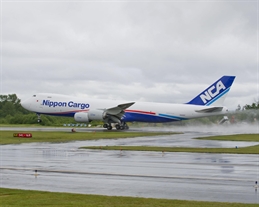
A heady combination of new blockbuster product launches and rising demand for airfreight across the board has airline executives rubbing their hands at the prospect of something that has been pronounced defunct by some observers and players. After a string of peak seasons to forget, air cargo operators are bullish that the rise in volumes they have witnessed recently augurs the return of real thing – strong demand chasing capacity in a prolonged rush to get goods to market before Christmas.
“Our outlook for the rest of the year is for the demand to continue to increase. I believe we will see an ‘old school peak season’ this year,” said Shawn McWhorter, president for the Americas at Nippon Cargo Airlines.
Last year’s peak season was a relatively modest spike both in terms of volume and duration, recalled James Woodrow, director of cargo at Cathay Pacific.
Air cargo statistics of recent months show rising demand for lift, especially out of Asia. For the third quarter, Hong Kong Air Cargo Terminals, the biggest handler at the world’s largest airfreight gateway, recorded a 7.6 percent increase in throughput.
Cathay Pacific and sister airline Dragonair registered a 19.7 percent surge in August over their cargo volume carried a year earlier, and their load factors gained 3.8 percentage points.
“Demand remained robust throughout August and the year-on-year tonnage increase was again well above expectations. Demand out of Hong Kong and the key manufacturing regions in mainland China remained strong and we hope to see a further uptick in September as new consumer IT products are launched in the market,” said Mark Sutch, Cathay’s general manager of cargo sales and marketing.
According to shipping research and consulting firm Seabury, high-tech shipments have been showing particularly strong growth, but a broad range of other commodities have also experienced gains in demand.
“We are seeing very strong demand from Asia to the US overall, and I am sure this is further increased by the iPhone 6,” agreed McWhorter.
However, the rise in traffic has failed to translate into stronger yields for the airlines, whose returns remain dismal. The biggest factor behind this has been the faster growth in airfreight capacity, despite the retirement of older freighters like the B747-200F and an increasing number of MD-11Fs.
According to Seabury, capacity growth has outstripped increases in demand in seven of the past eight years. In the past year new freighters entering the market have boosted capacity by some 400,000 tonnes, but bellyhold lift from new passenger planes has added 1.9 million tonnes over the same time. And while freighter deliveries are peaking this year, belly capacity will continue to grow by about 4,000 tonnes a year over the next five years.
Even those blockbuster product launches are not the feast for freighters of yesteryear, when a host of charters would be used to rush the latest must-have gadget to market. In an earnings call in September, Mike Glenn, president and CEO of FedEx Services, described a change in the way new products are launched. A larger number of shippers have bolstered the timeframe for their product launch, moving a larger portion earlier using slower modes of transport. This has flattened the large spike in launch shipments that characterized such events in the past, he noted.
This was echoed by Essa Al-Saleh, CEO and president of Agility Global Integrated Logistics, at the International Air Cargo Forum in Seoul in early October. He cited the launch of Apple’s iPhone 6 as an example for better planning of the logistics. Despite the volumes involved, the event did not produce any disruption in the air cargo market, he pointed out.
“What this means is that we have to look for new markets and grow our network,” he concluded.
Furthermore, air cargo continues to be affected by shipper’s efforts to squeeze cost out of their supply chain, with massive repercussions for their choice of mode of transport, although many air cargo executives reckon that the mode shift from air to ocean has largely run its course by now. Still there is pressure on the air cargo sector to up its game, argued Chris Welsh, secretary general of the Global Shippers Forum.
“The air cargo industry needs to be more competitive with other modes. Recent increases in volumes and demand may have seemed to be a good time for the industry to raise rates but that was impossible because of the competition from ocean freight, he commen
By Ian Putzger
Air Freight Correspondent | Toronto




